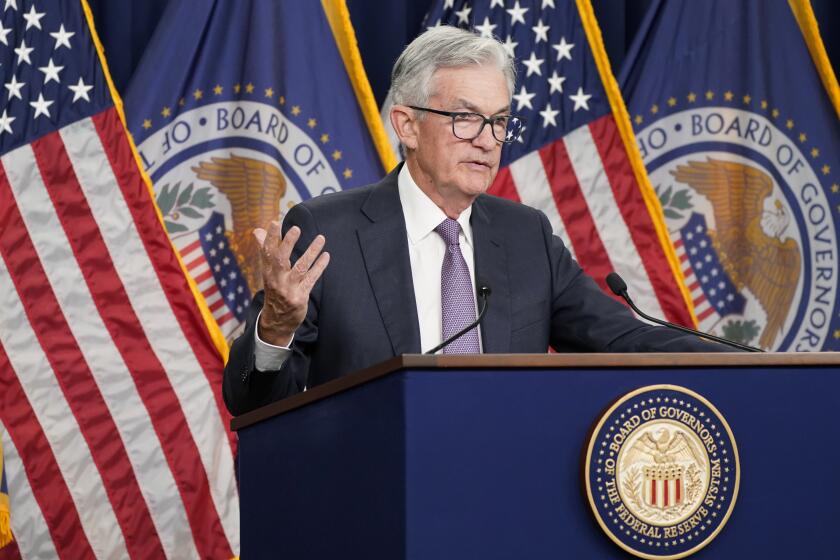Stocks end lower as hot jobs data signal aggressive Fed

- Share via
NEW YORK — Stocks on Wall Street gave up early gains and closed lower Tuesday after an unexpectedly strong report on the job market raised concerns that the Federal Reserve will need to keep the pressure on inflation with aggressive interest rate increases.
The Standard & Poor’s 500 fell 0.4% after having been up as much as 1% shortly after trading opened. The Dow Jones industrial average fell 0.2%, and the Nasdaq composite dropped 0.9%.
Big technology stocks were the biggest weights on the market. The companies, with their big valuations, have more heft in pushing the broader market up or down. Also, rising interest rates tend to make the sector look less attractive because of those high valuations. Apple fell 1.8%.
Communication services stocks, retailers and other companies that rely on consumer spending also helped drag down the overall S&P 500, keeping gains in banks, energy firms and other sectors of the market in check.
Small company stocks held up better than the rest of the market. The Russell 2000 rose 0.3%.
The Federal Reserve may reach a turning point this week as it announces what’s expected to be another substantial three-quarter-point increase in its key interest rate — its fourth straight.
The Labor Department reported that U.S. job openings rose unexpectedly in September, suggesting that the labor market is not cooling as fast as the Fed hoped for as it tries to slow economic growth.
The latest jobs data, which come ahead of a broader employment report Friday, are disappointing for investors who are looking for signs that inflation is easing and that the Fed might consider tempering its interest rate increases.
“That really fuels the expectation that the Fed has to do more hiking,” said Jason Draho, head of asset allocation for the Americas at UBS Global Wealth Management. “The labor market is still too tight for the Fed.”
Wall Street is concerned that the central bank is being too aggressive in slowing the economy, running the risk that it could bring on a recession.
Long-term Treasury yields turned higher after the report in job openings came out and rose back near multiyear highs. Those high rates have helped push mortgage rates above 7% this year.
A stolen wallet precipitates a reporter’s years-long fight against identity thieves — and a system that doesn’t care and won’t help.
The yield on the 10-year Treasury rose to 4.05% from 3.93% earlier in the morning.
The yield on the two-year Treasury, which tends to reflect market expectations of future moves by the Fed, rose to 4.54% from 4.40%.
“The issue for investors is figuring out how long the hiking cycle will last,” Draho said. Fed Chair Jerome H. “Powell will want to leave all options on the table.”
The S&P 500 fell 15.88 points to 3,856.10. The Dow dropped 79.75 points to 32,653.20. The Nasdaq slid 97.30 points to 10,890.85. The Russell 2000 rose 4.53 points to 1,851.39.
Stocks are coming off a strong rally in October that resulted in big monthly gains for some of the major indexes. Even so, they remain in the red for the year, including the S&P 500, which is down about 19%.
Don’t let the bear market keep you from retiring. But there are a bunch of other financial and emotional factors to consider before taking the leap.
Several big companies made solid gains after encouraging earnings reports and forecasts.
Pfizer rose 3.1% after reporting strong results and raising its profit forecast for the year. Uber surged 12% after giving investors a strong forecast for future bookings. Rival Lyft rose 3.5%.
Earnings remain a big focus for investors this week. Starbucks and Warner Bros. Discovery report earnings Thursday, and Cardinal Health does so Friday.
Apart from earnings, Abiomed surged 49.9% after healthcare giant Johnson & Johnson said it will pay $16.6 billion for the heart pump maker. Johnson & Johnson slipped 0.5%.
The Fed is beginning a two-day policy meeting that’s expected to result in its sixth interest rate increase of the year as the central bank fights the worst inflation in four decades. The widespread expectation is for the Fed to push through another increase that’s triple the usual size, or three-quarters of a percentage point.
For its final policy meeting of the year, in December, opinions are split among investors as to whether the Fed will make another three-quarter-point move or dial back to a half-point increase.
“The big focus is not so much on what the rate hike is going to be, but really what the comments are coming out of this week’s meeting in terms of any indications of whether there’ll be a little bit of softening as we move into early next year,” said Greg Bassuk, chief executive of AXS Investments.
More to Read
Inside the business of entertainment
The Wide Shot brings you news, analysis and insights on everything from streaming wars to production — and what it all means for the future.
You may occasionally receive promotional content from the Los Angeles Times.













